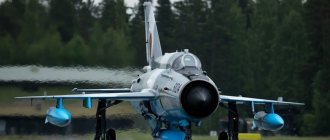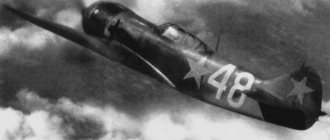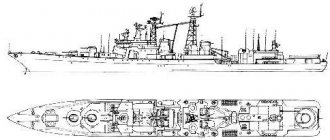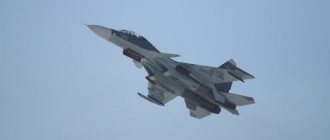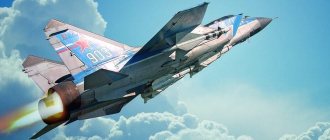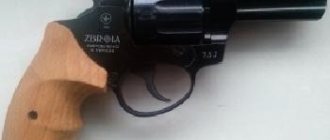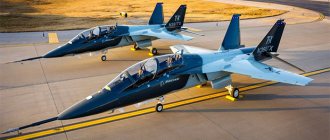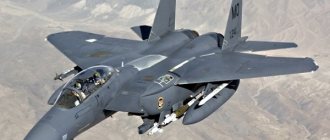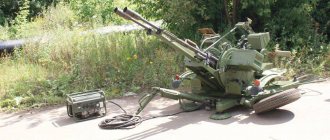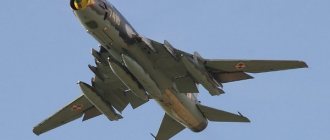The SU-35 aircraft is known as a multi-role fighter that has the opportunity to demonstrate its best qualities in confrontation with an air enemy. It can also deliver powerful strikes with high precision from long ranges against targets on land, sea and air.
The SU-35 fighter (according to the NATO version Flanker-E+) is an airship with super maneuverability. It was created on the basis of the T-10S platform of the Sukhoi Design Bureau. MIG-35 and SU-35 are 4++ generation aircraft. This is not the last word in military technology, but close to it.
The term “Generation 4++” shows that the performance characteristics of the SU-35 almost correspond to the level of the fifth generation. The lack of stealth characteristics and phased active array prevented the aircraft from being classified as the fifth generation.
The SU-35 aircraft appeared as a result of a deep modernization of the SU-27, a machine with excellent flight parameters. Multilateral modernization led to the creation of a new fighter. Innovations affected the design, equipment, capabilities and goals.
The beginning of the way
The SU-35 Rossiya prototype made its first takeoff in the spring of 1985. The new aircraft retained its external resemblance to the SU-27, but significantly changed its aerodynamic characteristics.
The aircraft's weapons can only be described in superlatives. This is a record number of missiles for fighters - 14. The total combat load of the vehicle is 8 tons.
Basic fighter missions
Unlike fighter-bombers and attack aircraft, whose weapons are aimed primarily at the destruction of land and sea targets, multi-role fighters are created primarily for air combat, the elimination of any enemy aircraft, helicopters and other aerial devices, although they can be used for missile attacks "air-to-ground".
In Syria, the main mission of the Su-35 was to cover transport aircraft and strike combat vehicles hitting ground targets in order to prevent a repeat of the incident with the destruction of the Su-24 bomber by a Turkish fighter on November 24, 2015. The “thirty-fives” also performed reconnaissance functions.
In August 2022, electronic media reported a new incident starring “artists” from the Turkish Air Force. The command sent a group of fighters into Syrian airspace, presumably to Idlib, where government troops successfully attacked militants of the terrorist organization Tahrir al-Sham (banned in Russia). According to anonymous observers, the Turks covered a distance of more than 40 kilometers, but as soon as their radar detected the Su-35, they turned around and took the opposite direction. True, there were no official comments about the episode, which journalists explained by the Sushki carrying out a secret flight, during which they allegedly “drived away” the Turkish provocateurs by accident.
Story
2006 was the year of production of the installation batch of machines. The premiere prototype was released in 2007. A year later the first flights began. By March 2009, the new product had already made one hundred flights.
At the MAKS-2009 air forum, the Air Force signed a contract with the manufacturer for 48 aircraft until 2015. Based on the results of the contract, the country’s military department plans to conclude a similar contract until 2022.
In 2010, information appeared on the results of preliminary tests, which proved that the vehicle met the required parameters for super-maneuverability and the presence of on-board equipment.
The Ministry of Defense received the first six SU-35S as part of serial production in 2012. After 2 months, its state tests started.
Further arrivals of new items look like this:
- 2013 - 12 pcs.;
- 2014 – 12 pcs.
Russian Aviation
In the history of our aviation there were two Su-35 aircraft. In the early 90s of the last century, the Su-27M aircraft, factory designation T-10M, which was a radical modernization of the basic Su-27 carried out in the 80s, was demonstrated at international air shows. This was the first attempt to make a multi-role fighter out of an interceptor.
The aircraft was equipped with a new radar, which provided the modernized Su-27 with expanded capabilities for using guided weapons, the weapons control system was changed, and to improve maneuverability, the designers installed a front horizontal empennage (FH).
In the 90s, with the collapse of the USSR and the subsequent economic crisis, funding for the program was practically stopped, and production of these aircraft was discontinued.
At the beginning of the 2000s, after a change in the country's political leadership, the needs of the domestic air force for new types of equipment were identified and trends in the development of global combat aviation were predicted, which outlined the urgent need for a radical modernization of the heavy Su-27 compared to what was done a decade and a half ago . In order to compete with modern and promising American and European fighters, it was necessary to significantly modernize the entire avionics of the aircraft and its weapons, improve the airframe design and replace the power plant with a more powerful one.
In 2005, when the concept of a modern multifunctional fighter was formulated, they returned to the index “35”, which was assigned to the deeply modernized Su-27. At first, the fighter was designated as Su-35BM - a major modernization, then the name was simplified to Su-35 with foreign buyers in mind. The interest of the Russian Air Force in this vehicle gave impetus to the development of the Su-35S variant - the letter “S” traditionally denotes variants of equipment for supply to the Russian army.
During the design of the new machine, design solutions were used that were tested in the Su-27 and Su-27UB flying laboratories in the mid-1980s.
Experimental T-10-24 with PGO
First of all, it was necessary to decide on the front horizontal empennage (FH), tested on the T-10-24, with a modified remote control system and an in-flight refueling system.
As a power plant, it was decided to install modified AL-31F engines with a thrust increased to 13,000 kgf, and to increase the flight range, use a PTB with a capacity of 2,000 liters. It was also decided to abandon the brake flap and transfer its functions to differentially deflectable rudders.
Especially for the Su-35S, NPO Saturn created the “4++” generation engine AL-41F-1C “product 117S” with an afterburner and all-aspect controlled thrust vector (TCV). In January 2008, tests of all five engines of the pilot batch were successfully completed, and by mid-February, ground testing of the aircraft's on-board systems was completed. The installation of a new engine, which significantly improved the maneuverability of the aircraft, made it possible to abandon the front horizontal tail, because controlled thrust vector ensured the aircraft stability and controllability at high angles of attack and at near-zero speeds.
The ultra-maneuverable multifunctional fighter Su-35S (Flanker-E+ according to NATO classification) belongs to the “4++” generation of fighters and is designed to intercept and destroy all classes of air targets in long- and short-range air battles, fight for air supremacy, and also to destroy ground and surface objects covered by air defense systems and located at a considerable distance from the home airfield. The Su-35S uses fifth-generation fighter technology. It can fly and fight in conditions where “classic” fighters of the “4” and “4+” generation cannot effectively conduct combat operations. The “4++” generation is conditional and only indicates that, in terms of its characteristics, this machine is very close to a fifth-generation fighter.
The Su-35S glider allows you to create unique figures in the sky. NATO and US pilots, when performing aerial maneuvers and aerobatic maneuvers, have to think and constantly keep numbers on angles of attack in their heads so as not to fall into a tailspin. The Russian aircraft allows you to forget about this; it can be taken out of any position without making much effort.
The main goal that the Ministry of Defense set for the designers of the Sukhoi Design Bureau was to create an aircraft of the transition period from the “4+” to the fifth generation. It was necessary to close the gap between the aging Su-27 fighters, which are gradually being phased out of the Air Force, and the PAK FA T-50 aircraft, which is yet to enter service with the Russian Aerospace Forces, presumably in 2022. For this purpose, the Su-35S has quite high performance characteristics, and in its capabilities it surpasses all 4+ generation fighters, such as the Super Hornet, Rafale and Typhoon, and is capable of withstanding the only fifth-generation serial fighter F today. -22, while being significantly cheaper than the Raptor.
The first flight model of the Su-35S was assembled at KnAAPO by August 2007. It was transported by An-124 “Ruslan” transport aircraft to Zhukovsky near Moscow, where it was demonstrated at the static parking lot of the MAKS 2007 air show. At the end of the air show and before the start of flight tests, ground testing of the aircraft’s systems and assemblies continued.
The first flight of a prototype of the new Russian fighter took place on February 19, 2008 at the airfield of the LII named after. Gromov in Zhukovsky. The aircraft was piloted by Honored Test Pilot of the Russian Federation Sergei Bogdan . On October 2 of the same year, a second prototype aircraft was connected to testing at the KnAAPO Flight Test Station. Thus, flight tests of the Su-35S were carried out simultaneously in both Zhukovsky and Komsomolsk-on-Amur.
On April 26, 2009, an incident occurred that, by a happy coincidence, resulted in no casualties.
“At the Dzyomgi airfield in Komsomolsk-on-Amur, while taxiing and running at high speed as a result of leaving the runway, the third flight model of the Su-35 fighter crashed. First class test pilot Evgeny Frolov ejected as usual and was not injured,” this was stated in the official statement of the Sukhoi company.
Witnesses give a more detailed picture of the incident: “Slow taxiing was carried out. The pilot set the engines to afterburner; they did not want to slow down. The sequence of what happened next: fire hydrants, emergency braking, braking parachute, brake failure due to overheating, departure from the runway, ejection. The plane's struts collapsed and it caught fire, but there was no explosion. Burning, it stopped 30 meters from the VOHR booth. The security guard was taken away by ambulance in a state of shock from fright. The pilot escaped with a blow to his butt..."
“Su35-4 burned out. He was jogging, according to the program he turned on the maximum thrust, at the end of the lane at the left engine the thrust does not reset, but remains at maximum. The pilot Evgeny Frolov contrived to turn around (by releasing the braking parachute and burning the brakes), but he was unable to release the gas and, having driven the entire runway, ejected. The plane jumped the heating pipes, broke the landing gear and caught fire 30 meters from the security post (the poor woman was said to have had a nervous breakdown). The reason turned out to be trivial: there was no gap between the engine thrust and the stiffening rib of the removable hatch, which was removed during the engine race, and the “jamb” did not come out.”
In an official statement from the Sukhoi Design Bureau regarding this incident, it was also said: “The third model of the Su-35 aircraft was planned to be connected in addition to the two models already being tested, which have now made more than a hundred flights. Taking into account the successful tests of the existing two flight models, the implementation timeline for the Su-35 program will remain unchanged.”
| Main technical characteristics | |
| Takeoff weight, kg: | |
| normal (2 x RVV-AE + 2 x R-73E) | 25300 |
| maximum | 34500 |
| Twin-circuit turbojet engine with afterburner and all-aspect UVT, model AL-41F-1C | |
| quantity, pcs | 2 |
| thrust, kg | 14500 |
| Maximum fuel reserve in internal tanks, kg | 11500 |
| Maximum combat load weight, kg | 8000 |
| Service ceiling, km | 18 |
| Flight range with maximum fuel load, km: | |
| H=0, M=0.7 | 1580 |
| Nkr, Mkr | 3600 |
| Ferry range with 2 x PTB-2000, km | 4500 |
| Acceleration time at an altitude of 1000 m with fuel remaining 50% of normal fueling, sec: | |
| from 600 km/h to 1100 km/h | 13,8 |
| from 1100 km/h to 1300 km/h | 8,0 |
| Maximum rate of climb (H=1000 m), m/s | >280 |
| Maximum flight speed: | |
| H=200 m, km/h | 1400 |
| H=11000 m, Mach number | 2,25 |
| Maximum operational overload, g | 9 |
| Take-off run length at normal take-off weight at full afterburner, m | 400-450 |
| Run length when landing on a concrete runway using a braking parachute and wheel brakes with normal landing weight, m | 650-700 |
| Length, m | 21,9 |
| Height, m | 5,9 |
| Wingspan, m | 14,7 |
The MAKS 2009 air show did not include demonstration flights of the Su-35S in its flight program, but was remembered for the fact that it concluded the largest deal in Russia in recent decades for the purchase of 48 new multirole fighters in 2012-2015.
In July 2010, it announced the completion of preliminary tests of the Su-35S, full confirmation of the established characteristics of the on-board equipment complex and super-maneuverability characteristics, and its readiness to undergo state tests for combat use together with Russian Air Force pilots.
Acceptance tests of the Su-35S-1 at the KnAAPO airfield, which included seven flights, were successfully completed by mid-May 2011, after which the aircraft was prepared for transfer to the Russian Ministry of Defense to participate in the state joint testing program. The plane was painted in blue-gray camouflage and received tail number 01 with the inscription “Russian Air Force”. On May 28, 2011, the lead model of the new multifunctional Su-35S fighter arrived at the State Flight Test Center of the Ministry of Defense in Akhtubinsk. The plane took off from Komsomolsk-on-Amur to Akhtubinsk on May 27, piloted by Colonel Alexei Pestrikov. An intermediate landing for refueling and rest was made in Chelyabinsk. The next day, May 28, the car arrived at the GLITZ airfield.
A year and a half later, on December 25, 2012, the Ministry of Defense received the first six production Su-35S fighters. By the end of 2015, the Russian Aerospace Forces had 40 Su-35S in service, and at the MAKS-2015 air show an agreement was signed for the supply of another 48 aircraft until 2020.
Armament
- Cannon: 1 × 30 mm GSh-30-1 aircraft cannon, 150 rounds
- Combat load: 8000 kg
- Suspension points: 12
- Armament mounted on suspensions: 8 URVV - R-27RE,
- R-27TE,
- R-77,
- 6 URVP S-25LD,
- X-29,
- X-59M,
- X-31A and P,
- KAB-500Kr,
- FAB-500, -250,
- OFAB-100,
- NAR S-8, S-13, S-25.
Externally, the Su-35S is very similar to the Su-27. It differs from the original T-10M in that it has no PGO, a shorter tail boom, no upper brake flap, and its functions are performed by differentially deflectable rudders. Due to the increase in take-off weight to 34,500 kg, the landing gear was strengthened, and the front support was made of two wheels.
The aircraft's wing is cantilever, the consoles have a sweep angle along the leading edge of 42o, the wing mechanization consists of deflectable flaperons and slats (toes). Flaperons with an area of 4.9 m2 perform the functions of both flaps and ailerons, deflection angles +35o...-20o. Two-section rotating slats with an area of 4.6 m2 are deflected by 30o. The flaperons are released and the slats are deflected during takeoff and landing modes, as well as during maneuvering at indicated speeds of up to 860 km/h.
The Su-35S avionics complex is integrated into the information and control system (ICS) and provides intelligent support for the pilot when using the aircraft’s weapons in a difficult combat situation. The ICS includes two central digital computers, means of switching and converting information, and an indication system that implements the “glass cockpit” concept.
The Su-35S cockpit is equipped with two color multifunctional LCD indicators of the MFI-35 type with a built-in display processor, a wide-angle collimator indicator on the background of the windshield and an aircraft control stick. 15-inch (diagonal 37.5 cm) displays have a resolution of 1400x1050 pixels.
Airplane control stick. 1 – Button to disable the automatic control system (ACS). Also under the pilot’s little finger there is a lever for temporarily disabling the self-propelled guns: while moving on autopilot, the pilot presses the lever and manually performs the maneuver, after which the self-propelled guns continues to fly the plane along a new course. 2 – Four-position OBE mode switch for selecting combat and navigation modes of the on-board equipment complex. 3 – Horizontal button. In case of loss of orientation in space, including when feeling unwell after overload, the pilot can press this button so that the plane automatically returns to straight motion with zero roll and pitch. 4 – Firing button for cannon weapons. The rockets are launched by a trigger. 5 – The “Maneuver-trajectory control” switch switches the aircraft to super-maneuverability mode. 6 – The joystick (joystick) for controlling the marker is responsible for the position of the cursor on the screen. (c) Marina Lystseva, https://fotografersha.livejournal.com/465322.html
The Radioelectronic Technologies Concern has developed a new strapdown inertial navigation system BINS-SP2. The system determines the aircraft's location autonomously without satellite navigation or communication with ground services. The same navigation system is installed on the 5th generation fighter PAK FA T-50.
The Su-35S radar system, within a 100° field of view, can detect targets at a distance of up to 400 km, as well as track up to 30 air targets and simultaneously fire at eight of them. Such capabilities are provided to the fighter by the new radar control system (RLCS) with the Irbis-E passive phased antenna array.
In a wider viewing area of 300°, similar targets are guaranteed to be detected at a distance of up to 200 km in the front hemisphere (against the ground – up to 170 km) and up to 80 km in the rear hemisphere (up to 50 km against the ground). “Ultra-stealthy” targets with an image intensifier of 0.01 m2 are detected by the Irbis at ranges of up to 90 km. The detection range of ground (surface) targets is: for an “aircraft carrier” type target (IEC 50,000 m2) – 400 km, “railway bridge” (1000 m2) - 150-200 km, “boat” (200 m2) - 100-120 km, “installation of operational-tactical missiles” and “group of tanks” (30 m2) – 60-70 km.
For comparison, the AN/APG-77 AFAR of the 5th generation fighter F-22 Raptor has a target detection range with ESR = 1 m² - 225 km in azimuth-speed mode and 193 km in LPI mode (the frequency changes more than 1000 times per second. ), cruise missile (0.1 m²) - 125-110 km. The instrumental range of the radar is 525 km.
Another subsystem for controlling the aircraft’s weapons is the OLS-35 optical-location station, which combines a heat direction finder, a laser rangefinder-target designator and a television channel. The use of modern elemental base, new algorithms and software gives the OLS-35 superiority over the OLS of other aircraft of the Su-27 and Su-30 family in terms of range and accuracy, as well as reliability. The area of review, detection and automatic target tracking by the optical location station is 90° in azimuth and +60°...-15° in elevation. The detection range of an air target by a heat direction finder in the front hemisphere is at least 50 km, in the rear hemisphere – at least 90 km. The laser rangefinder measures the distance to an air target in a range of up to 20 km, and to a ground target – up to 30 km. with a measurement accuracy of 5 m.
In addition, to ensure effective combat use in the air-to-surface mode, the aircraft can be equipped with a laser-television sighting station installed in a container on one of the weapon suspension points. The station provides detection, tracking, ranging and laser illumination of ground targets. With its help, adjustable laser-guided bombs can be used.
Control of on-board equipment, systems and weapons in the Su-35S cockpit is provided by buttons and switches on the aircraft control stick (see above) and engine control levers, as well as push-button frames of multifunction indicators. Thus, the HOTAS concept - joystick - is implemented on the aircraft. The development of indicators and a number of other avionics systems for the Su-35S aircraft is provided by the Ramenskoye Instrument Engineering Design Bureau and other enterprises of the Technocomplex Research and Production Center.
Today (2015-2017) the Su-35S is the most modern Russian fighter, with which only the F-22 Raptor can compete in its combat capabilities, and in terms of super-maneuverability characteristics it has no equal.
Updated (February 2016): On January 30, 2016, due to the worsening relations between Russia and Turkey, four Su-35S fighters were transferred to the Russian Aerospace Forces Khmeimim air base in Syria. Details here:
- Four Su-35S fighters deployed to Syria
- Konstantin Sivkov: The transfer of the Su-35S to Syria is associated with a new deterioration in relations between Russia and Turkey
Updated (February 2022)
- According to the press service of the Rostec State Corporation, at the beginning of 2022, the Russian Aerospace Forces included about 70 Su-35S fighters.
“This aircraft is capable of reaching a maximum speed of 1,400 km/h at the ground and 2,500 km/h at an altitude of 11 km. The flight range at low altitude exceeds 1,500 km, and at high altitude with two external fuel tanks - 4,500 km,” the report says. Russian Deputy Defense Minister Alexei Krivoruchko, during a visit to the aviation plant in Komsomolsky-on-Amur, where the aircraft is produced, told reporters that the current contract provides for the delivery of the last batch of 10 Su-35S fighters in 2022. In addition, according to the deputy minister, in the future the Ministry of Defense plans to sign an additional contract for these vehicles.
MAKS-2015, Frolov chakra, slowed down x2 MAKS-2017, Su-35S - flies like a UFO
- 02/20/2016 Su-35S multifunctional fighter - five interesting facts
- 03/18/2016 Why the Su-35S is called the most dangerous fighter in the world
- 03/24/2016 Su-35S pilot training complex will be built near Khabarovsk
- 03/04/2016 Russia will supply 10 Su-35 fighters to Indonesia
( 14 ratings, average: 4.86 out of 5)
Sukhoi Su-35 Su-35S aircraft
Peculiarities
As already mentioned, the SU-35 fighter is a modernized Su-27. When landing, the aircraft is braked by deflecting the rudders to the sides.
The SU-35S aircraft has AL-41F1S engines with thrust vector control. The engine was developed by a research and production company. The engines meet the conditions that must be met for the most modern fighter aircraft. Although the plane has an old control system, it allows it to move without afterburner at speeds above the speed of sound.
The aircraft's service life is thirty years or 6,000 flight hours.
Design and latest technology
The appearance of the Su-35 fighter is impressive and aesthetic. It has a swift predator-like shape with outstretched wings, a muscular neck and two vertical tail "fins" on which rotating steering panels are mounted.
Additionally, a front horizontal tail was installed, which improved the aircraft's controllability. For the airframe, the developments of the Su-27K, a fighter designed for operation on aircraft-carrying ships, were used. The case is made of titanium and aluminum.
The landing gear was strengthened and the suspension acquired additional reliable elements.
The cockpit is equipped with a K36 ejection seat.
The nose is equipped with an air flow receiver in the form of a spear, which is attached to the nose cone covering the radar. The vertical tail area has been increased to improve stability and maneuverability. The rear gargrot had to be increased in diameter, since modern equipment took up more volume than the previous one.
The drogue parachute also changed its location; it is now located at the top of the fuselage, forward of the fuel tank. The classified coating of the airframe in the form of spraying (Stealth technology) significantly reduces the radar and thermal signature of the aircraft.
Engines
Like other units, the power plant has undergone changes in the SU-35. The technical characteristics of the engines meet the requirements for the fifth generation of aircraft.
In addition to the main jet engines of the AL-41F1S aircraft, of which it has two, the SU-35 is equipped with an additional gas turbine engine with a power of 105 kilowatts, TA14-130-35. It is intended for use in an additional power unit, allowing powering 200V and 115V AC consumers with a power of up to 30 kVA and conditioning the cabin and compartments.
Baptism of fire
2016 became a responsible year for the Russian Aerospace Forces, as official tasks were assigned in Syria. To carry them out, the latest Su-35S aircraft were sent there. Aircraft are based at the Khmeimim airbase. The Russian airbase is located in a combat zone and aircraft are constantly in the air performing patrol, cover and reconnaissance operations.
The main task of the Sushki was to provide escort and air cover for other transport and military aircraft. The Russian Ministry of Defense noted that when a pair of Su-35s were positioned “in a counter-movement”, visibility reached 360 degrees within a radius of 200 km around.
The appearance of a new generation of Russian aircraft in the Syrian skies aroused genuine interest among military attaches of foreign countries. There were attempts to compare the Russian Su fighter and the American F-15 F/A-18 aircraft by foreign experts, which led to disappointing conclusions for US experts.
The Ministry of Defense, after a year of combat duty of the new aircraft in Syria, stated that the Su-35S fully corresponds to the declared characteristics and is superior to most foreign analogues, such as the F-22 Raptor, which belongs to the fifth generation. On November 23, 2022, a pair of Su-25 attack aircraft performed a combat mission to cover ground forces. At this time, an F-22 Raptor appeared in the immediate vicinity of the attack aircraft.
Which simulated an attack, released heat traps and maneuvered dangerously close to the VKS aircraft. Duty vehicles were scrambled from the air base. The speed of the Su-35S fighter made it possible to quickly reach the scene of the incident.
As the fighters approached, Raptor returned to base, ceasing his provocative actions.
Russian Defense Minister Sergei Shoigu officially announced that the military operation in Syria once again confirmed the high qualifications of Russian aviation.
Technical specifications
- The crew is 1 person.
- The wing area reaches 62 m².
- The wings' sweep angle is 42°.
- Length, m - 21.90.
- Height, m - 5.90.
- The wingspan is 14.75 m.
- The empty aircraft has a mass of 19 tons, an operating take-off weight of 25 tons, a maximum weight of 34 tons, and a fuel load of 11 tons.
- Engines: turbojet weighing 1520 kg, having an afterburner and controlled thrust vector, AL-41F1S. Thrust: 2 × 8800 kgf; afterburner: 2 × 14,500 kgf.
Flight parameters
The designers ensured the super-maneuverability of the SU-35. The technical characteristics of the aircraft and its flight parameters are given below:
- Max speed at low altitudes - 1400 km/h.
- Speed at high altitudes - 2500 km/h.
- Flight range: at an altitude of 3.6 km – 4500 km, at an altitude of 200 m – 1580 km.
- Run length: with a parachute for braking, normal take-off weight, application of brakes - 650 m, take-off run with full afterburner - 450 m.
- The ceiling is 20 kilometers.
- Rate of climb - 280 m/s.
- Wing load: maximum take-off weight – 611 kg/m², normal – 410 kg/m².
As we can see, the speed of the SU-35 is very decent.
Without taking your eyes and hands off
The implementation of the HOTAS (Hands On Throttle-And-Stick) principle also greatly facilitates the pilot’s work: the ability to control all systems without taking his hands off the controls.
RUS (aircraft control stick) and RUD (engine control stick) of the Su-35 are equipped with so many buttons, triggers, toggle switches and multi-position switches that you will not find on a game joystick. Which, however, is not surprising: an airplane is not a toy.
The perception of information is facilitated by the implementation of the principle of the so-called glass cockpit, when all the necessary parameters are displayed on two large displays with a diagonal of 15 inches and a resolution of 1400x1050 pixels.
There are no dial indicators on the Su-35 at all. Even the backup instruments are digital and located on a separate display with independent power supply. And the most important information is shown on a transparent display against the backdrop of the cabin glass. The “glass cockpit” of the Su-35 also has a head-up display on the windshield.
Armament
- Combat load - 8 tons.
- 12 weapons suspension locations.
The aircraft has several types of weapons:
- small arms and cannon;
- guided air-to-air missiles;
- unguided missiles and bombs;
- guided air-to-surface missiles.
The aircraft's small arms and cannon armament include a built-in GSh-301 automatic single-barrel cannon of 30 mm caliber with an increased rate of fire. The cannon is located on the right half of the wing and has an ammunition load of 150 rounds.
The SU-35 missile and bomb armament is located on launchers, ejection devices and beam holders.
Places for hanging weapons:
- wing consoles – 6 pcs.;
- wing tips – 2 pcs.;
- engines – 2 pcs.;
- center section – 2 pcs.
From air-to-air weapons, the aircraft can carry 8 R-27 medium-range missiles with radar or thermal homing heads. You can also use up to 10 RVV-AE homing missiles with radar heads or up to 6 short-range R-73 missiles with thermal homing heads.
The air-to-surface armament can include 6 homing missiles Kh-29T, Kh-29L and S-25LD with laser heads. In addition to missiles, the aircraft can be armed with adjustable bombs. To combat enemy ships, Kh-31A anti-ship missiles are used.
Unguided air-to-surface weapons can reach 8 tons. The number of bombs can reach 16 pieces.
Avionics
The SU-35, whose radar technical characteristics provide it with air superiority, is capable of detecting targets even at long ranges.
Radar station parameters:
- Diameter of the phase antenna array, cm - 0.9.
- Operates in the frequency range - 8-12 GHz.
- Viewing angle: 240°.
- The number of transceivers is 1772.
- Operating power - 5000 W.
- Maximum power - 20000 W.
- Targets are detected for oncoming courses with a dispersion area of 3 m² at a distance of 350-400 km, with an effective dispersion area of 0.01 m² - a distance of 90 km.
- 8 targets are fired at the same time.
- At the same time, target designation and detection of 30 targets in the air or 4 on the ground are carried out.
The N035 Irbis radar is capable of detecting targets with a dispersion area of 3 m² at a distance of up to 400 km. The radar station is enhanced by an optical-electronic integrated system and an optical-location station.
In addition to the electronic countermeasures already available on the SU-35, group electronic defense stations can be used.
The pilot's cabin is equipped with a holographic indicator, which is located on its windshield, and two displays operating in multi-screen mode.
In addition, there is a L-150-35 complex that warns about radiation exposure.
The optical location station allows you to track 4 air targets at a distance of up to 80 kilometers. Infrared sensors provide missile attack warning.
For electronic warfare purposes, the fighter is equipped with containers.
The most important
But all these details, for all their effectiveness, are of secondary importance. The main difference is that the Su-27 is only a fighter, and the Su-35 is a multifunctional combat aircraft, capable of not only fighting an air enemy, but also hitting targets on the ground. Of course, there is already a similar modification in the Su-27 family of aircraft - the Su-30. But the Su-30 crew consists of two people, because until recently one pilot was not able to simultaneously pilot the aircraft and control high-precision weapons.
The Su-35 control system allows you to do this. But a single cabin instead of a double cabin means a savings of 1.5 tons.
Comparison with F-35
The manufacturer defines the SU-35 as a 4++ machine, that is, having a number of properties inherent in the fifth generation. The ability to shoot down stealth aircraft gives the fighter its super maneuverability. The SU-35 has slightly different technical characteristics .
The aircraft's propulsion system makes it possible to perform complex maneuvers. Aerobatics SU-35 makes it possible to perform both “Pugachev’s cobra” and “Frolov’s chakra”.
European experts are somewhat skeptical about super-maneuverability, believing that in real combat low visibility is much more important than increased maneuverability. Stealth is a characteristic that a fighter initially possesses. Many experts believe that compliance with stealth requirements was the main requirement of F-35 customers. Since it has low visibility, it does not need high maneuverability.
However, on the other hand, despite the great importance of stealth technology for a fighter, it is not an invisibility cloak. Knowledge of air combat is constantly being updated. The first generations of military and post-war aircraft prioritized altitude, high speed, maneuverability and combat power. For subsequent generations, the requirements changed somewhat: the main thing was the speed of the SU-35, then maneuverability.
Experts highly appreciated the maneuvers performed by the SU-35 fighter at the Paris Air Show. Of course, they do not mean an unambiguous victory in the air, but a flight trajectory that cannot be predicted can cause failures in enemy missile guidance programs. At the same time, the SU-35 itself is capable of firing short-range missiles with the maximum probability of hitting an enemy aircraft.
The F-35 is maximally dependent on its low visibility and tries to avoid collisions in close air combat (“stabbing” is contraindicated for it). Close combat gives significant advantages to the SU-35. The Russian vehicle has a large arsenal of weapons and a long flight range. But the main strength of the SU-35 is its super-maneuverability, which is the stuff of legends. This characteristic has become the calling card of these aircraft. The cost of the SU-35 for the Russian Armed Forces is approximately $40 million.
Export supplies
On November 19, 2015, the state corporation Rostec announced the conclusion of a contract for the supply of 24 Su-35 fighters to China, China becoming the first foreign buyer of these aircraft. The contract amount was estimated at $2.5 billion. In September 2022, for this deal, the United States applied so-called secondary sanctions to China - restrictive measures were imposed on the equipment development department of the Central Military Council of the People's Republic of China and its chief Li Shanfu. In 2016, the Russian side transferred four aircraft to China, in 2017 - ten, and in 2022 - the remaining ten aircraft.
On February 20, 2022, the head of Rostec, Sergei Chemezov, told the media that the United Arab Emirates signed an agreement of intent for the purchase of the Su-35 with the Russian Federation.
On March 1, 2022, Vladimir Kozhin, Assistant to the President of the Russian Federation for Military-Technical Cooperation (MTC), announced the signing of a contract for the supply of Su-35 to Indonesia. Earlier, Rostec reported that Indonesia had been presented with a commercial proposal for 11 aircraft. The deal was valued at $1.1 billion; as of July 2021, implementation of the contract had not yet begun.
On May 16, 2022, a military-diplomatic source told TASS that Russia began production of the Su-35 under a contract with Egypt. According to the source, “at the Komsomolsk-on-Amur Aviation Plant named after. Gagarin, production of Su-35s began, intended for delivery to the Egyptian Air Force under a contract concluded in 2022.” Source o.
Buyers of SU-35
An order from the Ministry of Defense for these fighters is possible soon. In addition, four more foreign customers are interested in the aircraft.
The aircraft can be delivered to China, Vietnam, Venezuela and Indonesia. 24 units can be delivered to China. Another 60 aircraft are expected by other countries.
By 2022, the number of vehicles produced can be increased to 96 units. Currently, the contract for 48 fighters for the Russian Air Force is ending. The press reported that it was planned to order an additional batch of vehicles.
